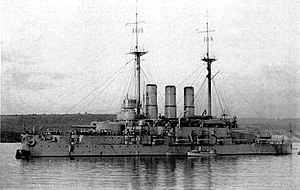 Evstafi at anchor, 1911
| |
| Class overview | |
|---|---|
| Builders | Nikolayev Admiralty Shipyard, Sevastopol Shipyard |
| Operators | |
| Preceded by | Borodino class |
| Succeeded by | Andrei Pervozvanny class |
| Built | 1903–1910 |
| In service | 1911–1918 |
| In commission | 1910–1918 |
| Completed | 2 |
| Scrapped | 2 |
| General characteristics | |
| Type | Pre-dreadnought battleship |
| Displacement | 12,738 long tons (12,942 t) |
| Length | 385 ft 9 in (117.6 m) |
| Beam | 74 ft (22.6 m) |
| Draught | 28 ft (8.5 m) |
| Installed power | 10,600 ihp (7,904 kW) |
| Propulsion |
|
| Speed | 16 knots (30 km/h; 18 mph) |
| Range | 2,100 nmi (3,900 km; 2,400 mi) at 10 knots (19 km/h; 12 mph) |
| Complement | 928 |
| Armament |
|
| Armour |
|
The Evstafi class were a pair of pre-dreadnought battleships of the Imperial Russian Navy built before World War I for the Black Sea Fleet. They were slightly enlarged versions of the Potemkin, with increased armour and more guns. Numerous alterations were made as a result of experience in the Russo-Japanese War of 1904–5 that seriously delayed the completion of the two ships.
They were the most modern ships in the Black Sea Fleet when World War I began and formed the core of the fleet for the first year of the war, before the newer dreadnoughts entered service. They forced the German battlecruiser SMS Goeben to disengage during the Battle of Cape Sarych shortly after Russia declared war on the Ottoman Empire in late 1914. Both ships covered several bombardments of the Bosphorus fortifications in early 1915, including one where they were attacked by the Goeben, but they managed to drive her off. Later, Evstafi and Ioann Zlatoust were relegated to secondary roles after the first dreadnought entered service in late 1915, and were subsequently put into reserve in 1918 in Sevastopol.
Both ships were captured when the Germans took the city in May 1918 and were turned over to the Allies after the Armistice in November 1918. Their engines were destroyed in 1919 by the British when they withdrew from Sevastopol to prevent the advancing Bolsheviks from using them against the White Russians. They were abandoned when the Whites evacuated the Crimea in 1920 and were scrapped in 1922–23.